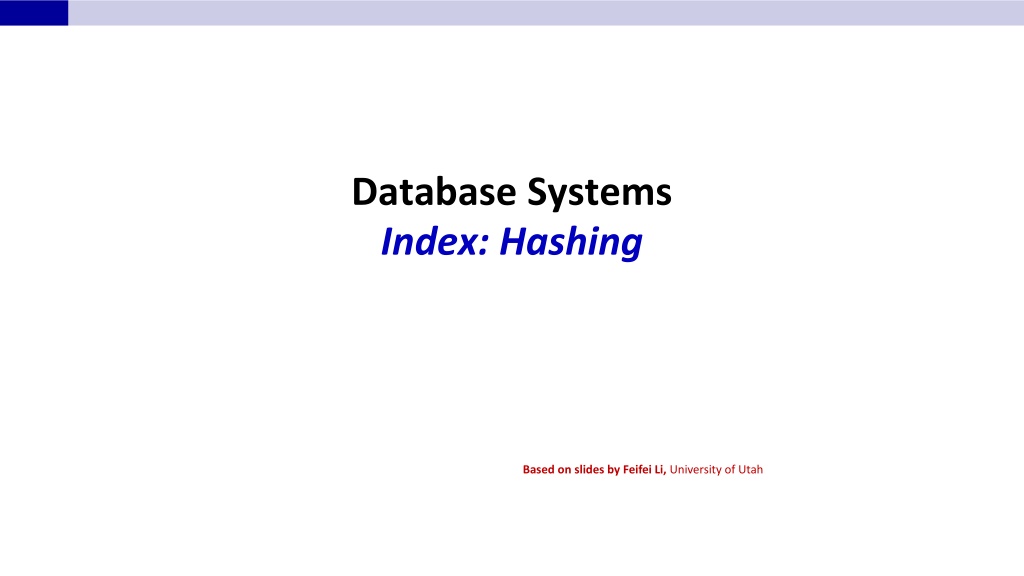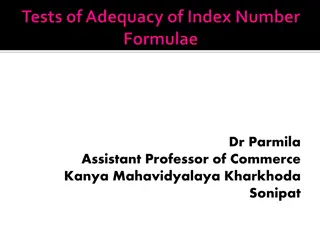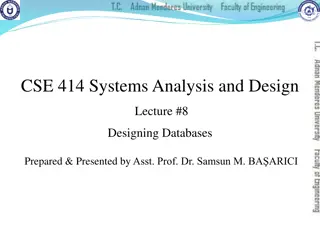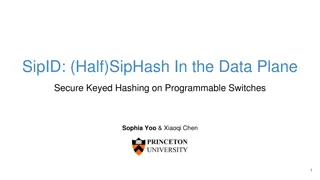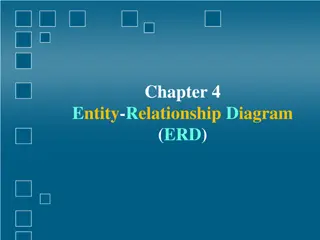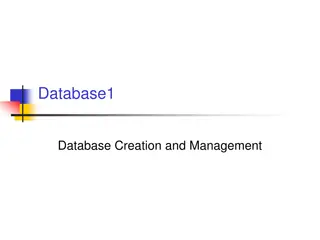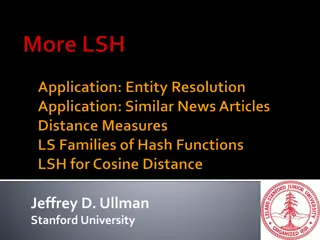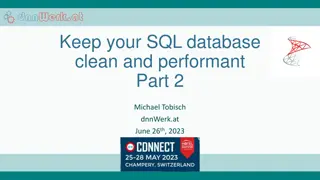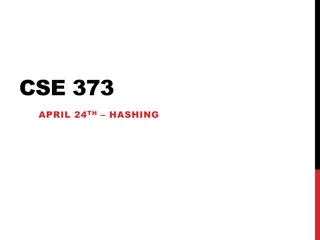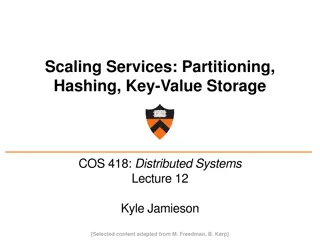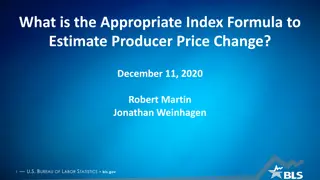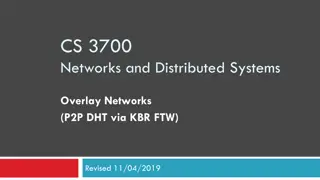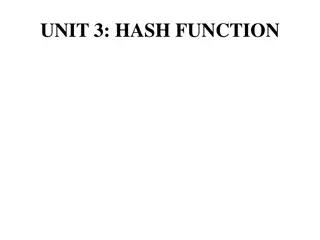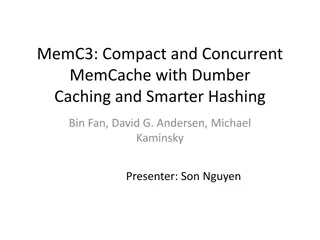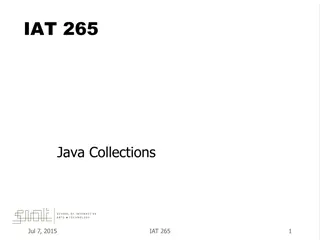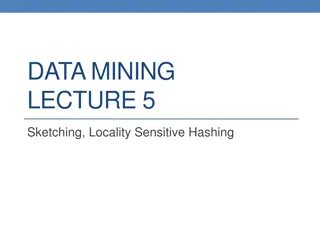Database Index Hashing Techniques
Hashing-based indexing in database systems is efficient for equality selections but not suitable for range searches. Both static and dynamic hashing methods exist, with static hashing involving fixed primary pages that are allocated sequentially. The process involves determining the bucket to which a data entry belongs based on a hash function. For scenarios where buckets become full, extendible hashing techniques are used to optimize performance and manage data overflow without incurring high costs.
Download Presentation

Please find below an Image/Link to download the presentation.
The content on the website is provided AS IS for your information and personal use only. It may not be sold, licensed, or shared on other websites without obtaining consent from the author.If you encounter any issues during the download, it is possible that the publisher has removed the file from their server.
You are allowed to download the files provided on this website for personal or commercial use, subject to the condition that they are used lawfully. All files are the property of their respective owners.
The content on the website is provided AS IS for your information and personal use only. It may not be sold, licensed, or shared on other websites without obtaining consent from the author.
E N D
Presentation Transcript
Database Systems Index: Hashing Based on slides by Feifei Li, University of Utah
Hashing Hash-based indexes are best for equalityselections. Cannot support range searches. Static and dynamic hashing techniques exist. 2
Static Hashing # primary pages fixed, allocated sequentially, never de-allocated; overflow pages if needed. h(k) MOD N= bucket to which data entry withkey k belongs. (N = # of buckets) 0 h(key) mod N 1 key h N-1 Primary bucket pages Overflow pages 3
Static Hashing (Contd.) Buckets contain data entries. Hash function works on search key field of record r. Use its value MOD N to distribute values over range 0 ... N-1. h(key) = (a * key + b) mod P (for some prime P and a, b randomly chosen from the field of P) usually works well. a and b are constants; lots known about how to tune h. more on this subject later Long overflow chains can develop and degrade performance. Extendible and LinearHashing: Dynamic techniques to fix this problem. 4
Extendible Hashing Situation: Bucket (primary page) becomes full. Why not re-organize file by doubling # of buckets? Reading and writing all pages is expensive! Idea: Use directory of pointers to buckets, double # of buckets by doubling the directory, splitting just the bucket that overflowed! Directory much smaller than file, so doubling it is much cheaper. Only one page of data entries is split. No overflowpage! Trick lies in how hash function is adjusted! 5
Example Directory is array of size 4. Bucket for record r has entry with index = `global depth least significant bits of h(r); If h(r) = 5 = binary 101, it is in bucket pointed to by 01. If h(r) = 7 = binary 111, it is in bucket pointed to by 11. 2 4* 12* 32* 16* LOCAL DEPTH Bucket A GLOBAL DEPTH 2 1 1* Bucket B 00 01 10 11 5* 7* 13* 2 10* Bucket C we denote r by h(r). DIRECTORY 6
Handling Inserts Find bucket where record belongs. If there s room, put it there. Else, if bucket is full, split it: increment local depth of original page allocate new page with new local depth re-distribute records from original page. add entry for the new page to the directory 7
Example: Insert 21, then 19, 15 21 = 10101 19 = 10011 15 = 01111 2 4* 12* 32* 16* LOCAL DEPTH Bucket A GLOBAL DEPTH 2 1 2 Bucket B 00 01 10 11 5* 1* 7* 21* 13* 2 10* Bucket C 2 7* DIRECTORY Bucket D 19* 15* DATA PAGES 8
Insert h(r)=20 (Causes Doubling) LOCAL DEPTH 3 3 LOCAL DEPTH 2 4* 12* 32*16* Bucket A 32*16* GLOBAL DEPTH 32*16* GLOBAL DEPTH 2 2 3 2 Bucket B 1* 5* 21*13* 00 1* 5* 21*13* 000 Bucket B 01 10 11 001 010 2 2 Bucket C 10* 10* 011 100 2 2 101 Bucket D 15* 7* 19* 15* 7* 19* Bucket D 110 111 3 3 Bucket A2 4* 12* 20* 12* 20* Bucket A2 (`split image' 4* (`split image' of Bucket A) of Bucket A) 9
Points to Note 20 = binary 10100. Last 2 bits (00) tell us r belongs in either A or A2. Last 3 bits needed to tell which. Global depth of directory: Max # of bits needed to tell which bucket an entry belongs to. Local depth of a bucket: # of bits used to determine if an entry belongs to this bucket. When does bucket split cause directory doubling? Before insert, local depth of bucket = global depth. Insert causes local depth to become > global depth; directory is doubled by copying it over and `fixing pointer to split image page. 10
Comments on Extendible Hashing If directory fits in memory, equality search answered with one disk access; else two. Directory grows in spurts, and, if the distribution of hash values is skewed, directory can grow large. Multiple entries with same hash value cause problems! Delete: If removal of data entry makes bucket empty, can be merged with `split image . If each directory element points to same bucket as its split image, can halve directory. 11
Linear Hashing A dynamic hashing scheme that handles the problem of long overflow chains without using a directory. Directory avoided in LH by using temporary overflow pages, and choosing the bucket to split in a round-robin fashion. When anybucket overflows split the bucket that is currently pointed to by the Next pointer and then increment that pointer to the next bucket. 12
Linear Hashing The Main Idea Use a family of hash functions h0, h1, h2, ... hi(key) = h(key) mod(2iN) N = initial # buckets h is some hash function hi+1 doubles the range of hi (similar to directory doubling) 13
Linear Hashing (Contd.) Algorithm proceeds in `rounds . Current round number is Level . There are NLevel (= N * 2Level) buckets at the beginning of a round Buckets 0 to Next-1 have been split; Next to NLevel have not been split yet this round. Round ends when allinitial buckets have been split (i.e. Next = NLevel). To start next round: Level++; Next = 0; 14
Linear Hashing - Insert Find appropriate bucket If bucket to insert into is full: Add overflow page and insert data entry. Split Next bucket and increment Next. Note: This is likely NOT the bucket being inserted to!!! to split a bucket, create a new bucket and use hLevel+1 to re-distribute entries. Since buckets are split round-robin, long overflow chains don t develop! 15
Example: Insert 43 (101011) Level=0, N=4 Next=0 44* 36* 32* Level=0 Next=1 9* 5* 25* OVERFLOW PAGES PRIMARY PAGES 14* 18*10* 30* 32* 31*35* 7* 11* 9* 5* 25* PRIMARY PAGES 14*18*10*30* 31*35* 7* 11* 43* 44*36* 17
Example: End of a Round Level=1, Next = 0 Insert 50 (110010) PRIMARY PAGES OVERFLOW PAGES Next=0 Level=0, Next = 3 32* PRIMARY PAGES OVERFLOW PAGES 9* 25* 32* 50* 66* 18* 10*34* 9* 25* 35* 11* 43* 66* 18* 10* 34* Next=3 44* 36* 43* 7* 11* 31* 35* 5* 29* 37* 44*36* 14* 30* 22* 5* 37*29* 14* 30* 22* 31*7* 18
LH Search Algorithm To find bucket for data entry r, findhLevel(r): If hLevel(r) >= Next (i.e., hLevel(r) is a bucket that hasn t been involved in a split this round) then r belongs in that bucket for sure. Else, r could belong to bucket hLevel(r) or bucket hLevel(r) + NLevelmust apply hLevel+1(r) to find out. 19
Example: Search 44 (11100), 9 (01001) Level=0, Next=0, N=4 44* 36* 32* 9* 5* 25* 14* 18*10* 30* 31*35* 7* 11* PRIMARY PAGES 20
Example: Search 44 (11100), 9 (01001) Level=0, Next = 1, N=4 OVERFLOW PAGES PRIMARY PAGES 32* 9* 5* 25* 14*18*10*30* 31*35* 7* 11* 43* 44*36* 21
Comments on Linear Hashing If insertions are skewed by the hash function, leading to long overflow buckets Worst case: one split will not fix the overflow bucket Delete: The reverse of the insertion algorithm Exercise: work out the details of the deletion algorithm for LH. 22
Designing Good Hash Functions Formal set up: let [N] denote the numbers {0, 1, 2, . . . , N 1}. For any set S U such that |S|=n, we want to support: add(x): add the key x to S query(x): is the key q S? delete(x): remove the key x from S efficiently! We consider the static case here (fixed set S). Note that even though S is fixed, we don t know S ahead of time. Imagine it s chosen by an adversary from ? ? possible choices. Our hash function needs to work well for any such (fixed) set S. 23
Static vs Dynamic Static: Given a set S of items, we want to store them so that we can do lookups quickly. E.g., a fixed dictionary. Dynamic: here we have a sequence of insert, lookup, and perhaps delete requests. We want to do these all efficiently. 24
Hash Function Basics We will perform inserts and lookups by having an array A of some size M, and a hash function h : U {0,... ,M 1} (i.e., h : U [M]). Given an element x, the idea of hashing is we want to store it in A[h(x)]. If N=|U| is small, this problem is trivial. But in practice, N is often big. Collision happens when h(x)=h(y) handle collisions by having each entry in A be a linked list. 25
Desirable Properties Small probability of distinct keys colliding: if x y S then Prh H[h(x) = h(y)] is small . h H means the random choice over a family H of hash functions. Small range: we want M to be small. At odds with first desired property; ideally M=O(N). Small number of bits to store a hash function h. This is at least O(log2|H|). h is easy to compute Given this, the time to lookup an item x is O(length of list A[h(x)]) 26
Bad News One way to spread elements out nicely is to spread them randomly. Unfortunately, we can t just use a random number generator to decide where the next element goes because then we would never be able to find it again. So, we want h to be something pseudorandom in some formal sense. (Bad news) For any deterministic hash function h (i.e., |H|=1), if |U| (N 1)M + 1, there exists a set S of N elements that all hash to the same location. simple pigeon hole argument. 27
Randomness to the Rescue Introduce a family of hash functions, H with |H|>1, that h will be randomly chosen from for each key (but use the same choice for the same key). Universal Hashing: if x y S then Prh H[h(x) = h(y)] 1/M. If H is universal, then for any set S U of size N, for any x U (e.g., that we might want to lookup, x may not come from S), if we construct h at random according to a universal hash family H, the expected number of collisions between x and other elements in S is at most N/M. 28
Property of Universal Hashing Proof: Each y S (y x) has at most a 1/M chance of colliding with x by the definition of universal . So Let Cxy = 1 if x and y collide and 0 otherwise. Let Cx denote the total number of collisions for x. So, Cx = y S,y x Cxy. We know E[Cxy] = Pr(x and y collide) 1/M. So, by linearity of expectation, E[Cx] = y E[Cxy] < N/M. 29
How to Construct Universal Hashing? Consider the case where |U| = 2u and M = 2m Take an u m matrix A and fill it with random bits. For x U, view x as a u-bit vector in {0, 1} u , and define h(x) := Ax where the calculations are done modulo 2. There are 2um hash functions in this family H 30Note that , so picking a random function from H does not map each key to a random place
Why it is a universal hash family? Proof: We can think of it as adding some of the columns of h (doing vector addition mod 2) where the 1 bits in x indicate which ones to add take an arbitrary pair of keys x, y such that x y. They must differ someplace, so say they differ in the ith coordinate and for concreteness say xi = 0 and yi = 1 Imagine we first choose all of h but the ith column. Over the remaining choices of ith column, h(x) is fixed. However, each of the 2m different settings of the ith column gives a different value of h(y) (every time we flip a bit in that column, we flip the corresponding bit in h(y) as we are doing addition modulo 2!). So there is exactly a 1/2m chance that h(x) = h(y)! 31
Perfect Hashing (for static case) We say a hash function is perfect for S if all lookups involve O(1) work. Na ve method: an O(N2 )-space solution Let H be universal and M = N2 . Then just pick a random h from H and try it out! Claim: If H is universal and M = N2 , then Prh H(no collisions in S) 1/2 32
Nave method: O(n2) space Proof: ? ? How many pairs (x,y) in S are there? Answer: For each pair, the chance they collide is 1/M by definition of universal So, Pr(exists a collision) N(N-1)/2M = N(N-1)/2N2 < 1/2. 33
A O(n) space solution (for static S) first hash into a table of size N using universal hashing. This will produce some collisions (unless we are extraordinarily lucky) then rehash each bin using Method 1, squaring the size of the bin to get zero collisions Formally: a first-level hash function h and first-level table A, N second-level hash functions h1,... ,hN and N second-level tables A1,... ,AN To lookup an element x, we first compute i = h(x) and then find the element in Ai [hi(x)]. We omit the analysis of this method. 34
Dynamic S? Cuckoo hashing: Linear space Constant look up time Pagh, Rasmus; Rodler, Flemming Friche (2001). "Cuckoo Hashing". Algorithms ESA 2001 35
K-universal hashing and k-wise independent hashing A family H of hash functions mapping U to [M] is called k-universal if for any k distinct keys x1, x2, . . . , xk U, and any k values 1, 2, . . . , k [M] (not necessarily distinct), we have Prh H [h(x1) = 1 h(x2) = 2 h(xk) = k] = 1/Mk . Such a hash family is also called k-wise independent. The case of k = 2 is called pairwise independent. Pairwise indepence: Pr[h(x)=a h(y)=b] = Pr[h(x)=a] Pr[h(y)=b] 36
Simple facts about k-universal hash families Suppose H is a k-universal family. Then a) H is also (k 1)-universal. b) For any x U and [M], Pr[h(x) = ] = 1/M. c) H is universal. Exercise: prove these claims? 2-universal is indeed stronger than universal The previous construction for universal hashing DOES NOT give 2-universal (since Pr[ ] = 1 and not 1/M as required above) 37
How to construct k-wise universal hashing? pick a prime p, and let U = [p] and M = p as well. p being a prime means that [p] has good algebraic properties: it forms the field Zp (also denoted as GF(p)) Pick two random numbers a, b Zp. For any x U, define: h(x) := (bx + a) mod p Claim: h(x) is 2-universal (note that there are O(p2) hash functions, i.e., |H|=O(p2)) 38
Proof for 2-universal note that for x1 x2 U Since a, b are chosen randomly, the chance that each of them equals some specified values is at most 1/p x 1/p = 1/p2 , which is 1/M2 as desired for 2-universality. 39
Apply it in practice and k-universal the same idea works for any field. So we could use the field GF(2u ) which has a correspondence with u-bit strings, and hence hash [2u] [2u ]. Now we could truncate the last u m bits of the hash value to get a hash family mapping [2u ] to [2m] for m u i.e., construct h(x) as in last slide and then mod m. Pick k random numbers a0, a1, . . . , ak 1 Zp. For any x U, define ( mod p ( then mod m) Claim: the above construction forms a k-universal hash family. 40
Summary Many alternative hashing scheme exists, each appropriate in some situation. k-wise universal hashing is very useful, as it gives k-wise independence, but large k value means that it s more expensive to describe the hash functions. 41
